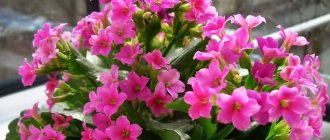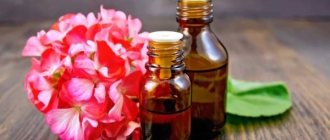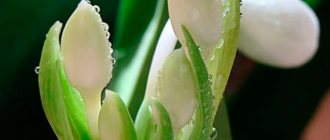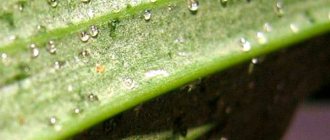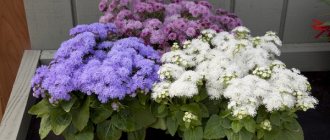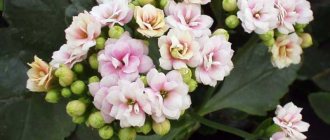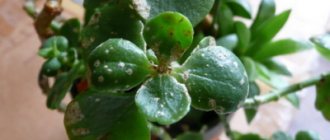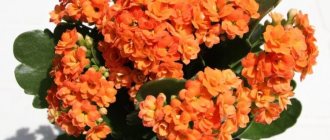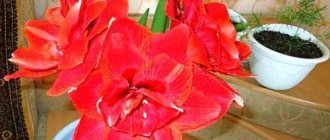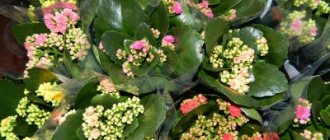How to make Kalanchoe bloom?
At the same time, stress allows you to spur the ejection of a bud, but only if it does not last long and is controlled from the outside. Experts know what to do if a previously flowering Kalanchoe no longer blooms and suddenly loses all its ovaries. The sequence of actions should be as follows:
- Increasing the frequency of watering. The soil under the succulent should be constantly moist for 2-3 days.
- Double dose of fertilizer. Spontaneous feeding outside the plan will force the plant to grow “dormant” ovaries.
- Loosening the soil at the roots. Aeration of the root system enhances the immunity of the buds.
Kalanchoe Blossfeld does not bloom - what to do?
There are at least 130 varieties of the Blossfeld variety: each of them has small double flowers in a wide variety of shades - pink, orange, red and yellow. Kalanchoe Blossfeld does not bloom if it grows in a dark place. It also does not like direct light, but responds with a large number of ovaries to bright light. The correctness of care that stimulates flowering can be determined by two criteria:
- The presence of a red border on the leaves of the plant. When Kalanchoe does not bloom, ovaries do not appear if the leaves have a uniform green color. The red “stripe” signals that the plant is receiving the required amount of water and nutrients.
- No fungal diseases. If brown spots appear on the leaves, they are removed and the cut areas are treated with a fungicide.
Kalanchoe Kalandiva does not bloom
The Kalandiva variety is considered the most adapted to living in an apartment or house. Its bright double flowers are collected in large inflorescences, so if one inflorescence dies, the petals of the neighboring ones also dry out. It has one peculiarity: while other succulents lose their ability to bear flowers due to moisture getting on the leaves, Kalandiva, even considering that it is a subspecies of Kalanchoe, does not bloom unless it is sprayed. It does not tolerate dry air very well, so you need to spray the plant with water at room temperature at least 2-3 times a day.
How to prune Kalanchoe to bloom?
Pruning is recommended for any type of this ornamental plant as a measure to stimulate flowering. The process involves removing excess leaves or diseased peduncles to prevent the development of diseases and give a neat shape.
Since as the stem develops, the upper shoots tend to thin out and become sterile, it is important to know how to properly pinch a Kalanchoe to bloom. These two processes (pinching and cutting) are similar to each other, so they can be combined into one:
- First you need to select the weakest tops of the plant, which have not been covered with flowers for a long time.
- Using scissors or fingers, a small part of the stem is removed with the expectation that the remaining wound will be small.
- After pinching, the edges of the stems are sprinkled with ash or charcoal to prevent dying.
Kalanchoe flower - how to care for it to bloom?
In order for ovaries to appear on a houseplant, its care regimen must be radically revised. You don’t need to think about how to make Kalanchoe bloom at home—you just need to eliminate factors that impede this process. These include:
- Excess sunlight. Constant stay on the windowsill, located on the sunny side of the home, causes the plant to grow in height, spending all the juices on this process.
- Avoiding overwatering. The leaves of the bush are able to accumulate moisture and consume it gradually, so a lack of water is not as destructive as its excess. In summer, the procedure must be repeated once a week, in winter - twice.
- Fertilizer with a special complex for succulents. If a Kalanchoe does not bloom, no matter what its owner tries to do, this may mean that it needs a mineral complex with potassium, sodium and manganese in its composition.
Where should a Kalanchoe flower be placed according to Feng Shui?
flowering Kalanchoes are located on the southern part of the house, therefore they bloom profusely.
According to Feng Shui, the best locations for Kalanchoes are:
- window sills on the south side of the house,
- the extreme left corner of the home - to attract abundance and wealth to the owners,
- left corner from the computer monitor for those who work in the dark. The plant absorbs fatigue and replenishes the worker's strength.
So, we have looked at the main stages of caring for a flowering Kalanchoe, the reasons for its drying out and pulling up. We learned about the benefits and favorable signs of having a plant in the house.
Get yourself a Kalanchoe if you haven’t already, and test the power of its healing effects in practice.
How to choose a good Kalanchoe flower in a store
To select a healthy and viable plant in the store, you must follow these rules.
Stem
During an external inspection, you need to check the safety of the stem and its elasticity. Determine how firmly the plant is rooted in the substrate. If the plant stem “dangles” in the container, there is a fairly high risk of hidden mechanical damage to the root system during transportation.
Important! You should choose a plant with an even distribution of foliage on the stem, without bald spots. The presence of a bare stem indicates injury to the plant.
Leaf color
In terms of color, the leaves and stem of the plant should have a uniform, uniform color, without white bloom, brown spots and yellowed edges of the leaf blades. It is necessary to especially carefully check the condition of the lower leaves; they must be healthy, not wrinkled, or darkened from excess moisture.
Inflorescences
In flowering species, it is necessary to carefully examine the inflorescences. They should contain as many closed buds and barely blooming flowers as possible. The presence of faded inflorescences and, especially, drying panicles in the selected specimen indicates that the plant has been blooming for a long time, and soon it needs to be prepared for a dormant period.
Substrate
It is very important to check the condition of the earthen substrate in the transport container. The earthen ball should not be too wet, and in the lower part near the holes for draining the liquid it should not be sour
Excessive humidity and mass processing of plants in chain supermarkets can harm the plant and stimulate the process of rotting of the root system, which can lead to subsequent withering of the plant.
It is better to choose plants with a dry earthen lump. Excessive waterlogging is more likely to kill Kalanchoe than short drying. Thanks to its succulent properties and ability to accumulate liquid in the stem and leaves, Kalanchoe is able to withstand short-term drought without serious consequences.
Important! When purchasing, you need to choose the right Kalanchoe. Home care after purchase involves observing an adaptation period and further transplantation
Kalanchoe is a short-day plant. To stimulate the budding process, a short day lasting less than 8 hours is artificially created. To do this, cover the bush with a cap that does not allow light to pass through, or put the pot in a closet.
How to replant a flowering Kalanchoe?
young Kalanchoe seedlings in pots after transplanting
Consider a number of parameters before transplanting:
- choose the diameter of the new pot a couple of centimeters larger than the previous one
- plan the procedure for the end of March - mid-April and repeat every year
- maintain soil composition to speed up plant adaptation
Procedure:
- fill the new pot with drainage and soil 50%
- Carefully remove the Kalanchoe from the old pot. Leave its roots with a lump of earth
- install in a new flowerpot and add soil
- lightly tamp the soil around the stem
- Water the plant in a new pot moderately
- feed it for a week until it fully adapts
Care
Location and lighting
Loves bright rooms with diffused light. In the summer, it should be placed on windows located towards the west and east. Direct sunlight should be avoided to avoid leaf burns. Loves fresh air, but drafts should be avoided. In winter and during the flowering period, you can use phytolamps if daylight is not enough (the plant begins to stretch and the inflorescences become smaller). The complete absence of light also negatively affects indoor plants.
Temperature
The Kalanchoe flower can easily withstand high temperatures in summer, up to thirty degrees or more. In winter, you need to maintain a cool temperature of +16-18 degrees (not lower than +10), this helps the rapid formation of flower buds. When it is cool, the flower becomes comfortable to bloom. If the room is too hot, this process is suspended.
Air humidity
Air humidity does not play a key role in the life of a plant. Kalanchoe thrives in both dry air and high humidity. There is no need to spray the plant, but sometimes you can wipe the leaves with a damp cloth or sponge to remove dust. After this procedure, it is necessary to repeat wiping with a dry cloth.
Watering
Moderate, with drying out of the top layer of soil. In summer - about 1-2 times a week (but do not forget to check the soil). In winter, watering should be done a minimum number of times. Kalanchoe can tolerate an insufficient amount of water, but an excess will destroy it, because... may lead to root rot. If the soil dries out greatly, the plant may shed its leaves.
The soil
For such an unpretentious plant as Kalanchoe, you can choose any soil for succulents. It can usually be found in many flower shops. A skilled gardener can create such soil himself. To do this, you need to mix peat, turf and leaf soil in equal quantities. You can add charcoal. It is necessary to put drainage at the bottom of the flower pot.
Fertilizer
It is enough to fertilize non-flowering species once a month during the growth period (spring-summer). They bloom once every three weeks in spring and summer, and also in autumn (for the formation of flower buds). In cold weather, you should absolutely not fertilize the plant. Even if it withers, you cannot fertilize it in winter. It is recommended to use store-bought fertilizers for succulents or complex fertilizers (mineral and organic) with a low nitrogen content.
Transfer
It is necessary to replant a houseplant if the flower pot in which the Kalanchoe is currently located becomes too small for it. Replanting may also be required when the plant’s soil begins to rot after prolonged watering.
Young Kalanchoe requires annual replanting due to the rapid growth of roots. It is recommended to do this when the spring period ends. To replant, you need to take the plant out of the flower pot along with a small amount of soil, place it in another and water it.
Then the plant begins to slowly adapt to its new “place of residence.” In the new pot, it is necessary to maintain equal proportions of new soil and existing soil. Most often, Kalanchoe goes through an adaptation period of seven days. After which you can feed the flower. When choosing a new flower pot, you should choose wide and deep shapes. .
Replanting Kalanchoe at home
The succulent does not need frequent transplants, and the need for the procedure is determined by the size of the plant. Once the bush has outgrown its pot, replace it with a larger pot. Young plants develop rapidly, so they will have to be replanted every spring. But old large plants can be left in the same container. Just replace the top layer of soil, and rejuvenate the plant itself a little by cutting it.
After purchasing the Kalanchoe, it is advised to also replant it, since it usually grows in transport soil. But not immediately, but after giving the plant about a week to adapt to new conditions.
Kalanchoe is not particularly picky about soil, but, like any succulent, it prefers a loose substrate. The main thing is that it allows water and air to pass through well. Stagnation of water is detrimental for a plant that makes its own reserves. A ready-made substrate for cacti is suitable.
If you don’t trust store-bought soil, prepare the soil mixture yourself by mixing equal parts:
- sand;
- peat;
- turf land;
- leaf soil.
To prevent putrefactive diseases, add charcoal to your home soil. To prevent the roots from coming into contact with water flowing to the bottom of the pot after watering, lay expanded clay drainage.
Origin of Kalanchoe
The described inhabitant of the windowsill is considered a medicinal representative of the flora, often used for nasal congestion and other inflammatory processes. The question of whether flowering Kalanchoe can be used for medicinal purposes is still controversial. But even if it is impossible to get rid of a runny nose with the help of such a plant, it will delight its owners with its flowers.
This type of indoor decoration belongs to the Crassulaceae family, and translated means “plant with thick skin.”
The island of Madagascar is considered the birthplace of the green creature, but its growth can be found almost throughout Asia. The flowering beauty is grown both in greenhouses and in the room. This type of indoor decoration belongs to the Crassulaceae family, and translated means “thick-skinned plant.” Thanks to its thick stems and leaves, it accumulates moisture and goes without watering for a long time. Evaporation is prevented by a thin film covering the leaves and stems. All these features must be taken into account in order to care for a blooming creature.
Let's highlight the basic principles of care:
- Watering mode.
- Requirements for illumination and temperature.
- Transfer.
- Reproduction methods.
- Feeding, pruning.
- Protection from diseases.
Now let’s try to consider each of the mentioned principles in detail.
Video clip on how to grow Kalanchoe at home
What kind of soil is needed for Kalanchoe?
a mixture of soil in the hands of a girl before pouring into pots for replanting Kalanchoe.
The ideal composition of soil for replanting and growing Kalanchoe at home is a combination of elements from equal whole and half parts. Namely:
- leaf humus, turf soil and coarse sand, taken in equal whole shares
- charcoal and brick chips - in halves
Use bone meal as fertilizer. 1 g per 1 liter of soil mixture is sufficient.
- Observe the acidity level of the soil for Kalanchoe. The first can vary within 5.0-6.5 pH.
- You can either buy a ready-made mixture in specialized stores, or prepare it yourself. In the second case, additional sterilization is needed.
Why does Kalanchoe start to grow upward and stop blooming?
There are several reasons why a plant does not produce flowers. The main ones are:
- Lack of knowledge by the owner of the flower about the technology of growing the plant. After all, in the store the seller said that this potted crop does not require special care.
- There is not enough lighting for flowering. As a result, the shoots begin to stretch; they simply do not have enough strength to begin to form inflorescences.
- Very often, when we come to the store, we see flowering bushes. It seems to us that this culture is constantly blooming. But this impression is deceptive. To get this look, flower suppliers, before sending them to the store, achieve the appearance of buds by ordinary forcing.
- A small plant with a small root system is planted in a transportable pot. The soil in it contains special fertilizers that are valid only for two months. This Kalanchoe is kept for several days in a short daylight hours, usually 10 hours. The bushes begin to lay flower buds.
- When such a plant turns out to be in good home conditions, where normal lighting and temperature are created for it, it continues to bloom, thanks to the nutrients remaining in the pot.
To see a flowering bush again, you need to help the plant, it must gain strength and begin to bloom in good home conditions.
Bloom
When and how often does Kalanchoe bloom at home?
Kalanchoe is one of the most ornamental plants, which is valued primarily because of its long flowering, bright large flower caps of a wide variety of colors and shades.
When does Kalanchoe bloom?
Compact Kalanchoe often delight the eye when there is a snowstorm outside the window. And therefore, flowering period of Kalanchoe .
Flowering period: Kalanchoe can be in bloom already at the end of January, but sometimes it happens that they do not bloom, last a long time, then the plant drops them by the beginning of March.
Kinds
Let's look at several popular types of Kalanchoe, often used in indoor floriculture.
Benta
A plant with good decorative properties. A tall, unbranched shrub with a powerful stem and large leaves. It blooms with large white flowers, up to 2.5 centimeters in size. Blooms in April-May, likes cool weather.
Beharskoe
A plant with bare stems and entire pubescent leaves. The length of the leaves reaches 20 centimeters, width - 10. It blooms with small yellow flowers collected in umbrellas.
Blossfeld
The plant has a long flowering period. It reaches a height of 30 centimeters. It has dark green, rounded leaves. The flowers are most often red, but can be yellow, orange or pink.
Felt
Due to the special shape of the pubescent leaves, densely located on the stem, the plant is called “cat ears”. It blooms with small multi-colored flowers that combine red, purple, and silver tones.
Degremona
It can reach half a meter in height. It has fleshy leaves, on the edges of which small rosettes are formed - babies that can take root and germinate. It blooms in winter with bell-shaped inflorescences, purple or pink. Has strong medicinal properties.
Large-flowered
It grows up to 60 centimeters in height, has light green, sometimes reddish leaves. Yellow flowers are collected in umbrellas. Flowering period is May. The birthplace of the flower is India.
Mangina
The plant is distinguished by large pink inflorescences of 10-15 pink bell-shaped flowers. Active flowering occurs in spring.
paniculate
The plant reaches a height of 60 centimeters, densely covered with large silvery leaves. The lower ones are arranged in the form of a rosette, and the upper ones grow less frequently. It blooms with yellow small flowers collected in paniculate inflorescences. Flowering period - late April or May.
Marble
It has oblong leaves with a serrated edge. The plant got its name because of the original color of the leaves. From green they gradually become gray, with brownish splashes. It blooms with white flowers, united in peculiar umbrellas. Has a long flowering period (from January to April).
Cirrus
Cirrus Kalanchoe reaches a meter in height. Densely covered with thick serrated leaves on which daughter rosettes form. Known for its medicinal properties.
Fiery
A low plant with a slightly branched trunk. It blooms with bright red large flowers collected in umbrellas. Does well in cool rooms.
Tubular-flowered
Tall shrub with large oblong leaves. Blooms with beautiful red flowers. The corollas are arranged in the shape of a tube up to 2.5 centimeters long. The plant has many varieties, with flowers in all shades of red.
Dissected
The vertical stem of the bush changes direction of growth over time and begins to droop. It has light green waxy leaves with dissected edges. Blooms with bright orange flowers.
Don Sergio
It has a long flowering period and is very decorative. Thick dark leaves combine pleasantly with bright double inflorescences. The flowering period begins at the beginning of winter.
Kalandiva
A low plant, distinguished by abundant dense double flowers. Large glossy leaves growing in pairs make the plant even more beautiful.
Mix
The plant has a long flowering period (up to six months). It is distinguished by its richness of shades when flowering, unpretentiousness and good healing qualities.
Rosaline
The compact plant blooms with double flowers in delicate pastel colors. It has round, glossy leaves with a wavy edge.
Content Features
Kalanchoe without flowers does not look very presentable. With proper care, the compact bush quickly produces buds. Thanks to the work of breeders, they can have different shades.
Flowers can have different colors
Flowering frequency
As a rule, Kalanchoe blooms at the end of January and continues until the end of spring. But there is a special technique that allows you to extend this period until September.
For your information! Under the right conditions, the succulent sheds flowers and gains new buds; this can happen once a season. If maintained poorly, the plant will not develop.
Some types
Thanks to selection, it was possible to develop several hundred varieties of Kalanchoe.
- Kalandiva is distinguished by its miniature size. The height of the variety rarely exceeds 30 cm, and the stems are densely strewn with small flowers of different shades.
- Degremon is capable of growing up to one meter in height. It has bright leaves: the inside is gray-green and the outside is dark green. It blooms rarely and only in winter, the inflorescences are paniculate.
- Laciniat has an unusual leaf shape. They resemble branched deer horns and are painted a rich green color. This species has no color and is attractive only for its feathery leaves.
- The dissected variety also has similar characteristics. Paniculata Kalanchoe attracts attention with its round silvery leaves. Small inflorescences appear only in April or May.
The mix variety has different flower colors - white, pink, lilac, etc.
Note! Kalanchoe has double inflorescences, that is, consisting of many petals, which makes indoor plants decorative and beautiful.
Kalanchoe - how to care after flowering
Question: What to do after Kalanchoe blooms, when it has branched out greatly, like a tree, and is almost bald. Is it possible to trim it and how to do it?
Agava: Kalanchoe can be cut any way you like! You can cut cuttings and stick them in the same pot, you can even leave one stump - it will sprout and curl. The only thing is that this applies to the ordinary Blossfeld Kalanchoe, which blooms red. All sorts of hybrids such as white, yellow and pink may die completely after flowering.
Nathanella: There are only two options for how to deal with faded Kalanchoe:
- Take cuttings, root them and get a new plant. It will bloom when it becomes old enough, i.e. probably in a year. Ideally, Kalanchoe Blossfeld is a tall, erect plant (50 cm) with a non-branching stem, so pinching does not give any results. We sell Dutch specimens, which are apical cuttings from an already mature plant. It is not difficult to make them bloom, the main thing is to observe the light regime.
- Try to arrange a “dark” one for an adult plant and get a flowering bush. Kalanchoe is a short-day plant, i.e. In order for the bush to bloom again, it should be darkened from about 5 pm to 9 am the next day. Daylight hours should not exceed 8-10 hours. This simple procedure should be done for a month and then the Kalanchoe will bloom again. But first you need to remove the old peduncles.
Tip: “dark” can be arranged using a dark plastic bucket. After flowering ends, cut off the flower stalks and put the plant on a shady windowsill, hardly water it for a month, then move it to a bright place and start watering and caring for it as usual. Well, don’t forget that Blossfeld’s Kalanchoe is still a succulent plant, so it should be cared for as a succulent.
Question: My Kalanchoe has already bloomed for the second time, it doesn’t seem to be going back, so it’s time to send it to rest. I know I need to cut his hair. Just want to know specifically what to cut and how much to cut?
Buttercup: Trim flower stalks. But the height of the bush is whatever you want.
Care after purchase
You can find different types of Kalanchoe in the store. You need to choose specimens with intact, healthy leaves. They should not be scratched, damaged or look limp. Preference should be given to bushes with a large number of buds.
Important! The stems are also inspected for damage and rot.
Kalanchoe needs to be carefully checked for pests. The bush should be free of plaque, scabs and small bugs. After the plant is brought home, it is quarantined for two weeks. At this time, the pot with the plant is placed in a separate room. This measure is necessary to prevent the spread of pests and diseases in the apartment.
Caring for Kalanchoe is very simple. The flower is transplanted into a clay pot (it should be 1.5-2 cm larger than the earthen ball). Kalanchoe needs diffused light, but it must be protected from direct sunlight. The optimal temperature is 20 °C. The plant needs to be watered as the soil dries out. Usually 2-3 waterings per week are enough.
Note! Flower growers do not always know how Kalanchoe blooms. Many are sure that these are just green succulents. With proper care, buds will appear in the spring. After flowering begins, the pot cannot be moved from place to place, otherwise the Kalanchoe will be stressed and drop its flowers.
Additionally, fertilizers are used for flowering plants. They help replenish nutrient deficiencies in the soil. With this care, Kalanchoe can bloom 3-4 times a year.
When caring for a flowering plant, you need to carefully monitor the drying out of the soil. Lack of moisture will negatively affect the formation of buds.
As soon as the Kalanchoe decides to bloom, it is moved to a bright place. It cannot be pruned until the flowering process is complete. Drying inflorescences can be carefully removed so that the plant does not waste its energy on it.
Blooming Kalanchoe can be moved to the balcony in summer
Important! The plant needs to be given a break between blooms. This is important for the formation of green mass and growth of the root system. To do this, stop abundant watering and fertilizing for three weeks. You can move the pot to a slightly shaded place.
Reasons for lack of flowering
With good care, the plant has beautiful leaves with wavy, pointed or smooth edges and blooms in dense clusters with small flowers. If you buy a Kalanchoe at a flower shop, you usually buy an already flowering specimen and expect the same lush and lush flowering as when you bought it. But after a couple of months, the flowers fall off and dry out, and new buds stop forming, the branches become elongated, and the leaves become smaller. Therefore, any gardener who grows this flower for the first time has a question about why Kalanchoe does not bloom and grows upward.
Problems with flowering occur with many types of flowers, some are difficult to get to bloom at all, especially if suitable conditions are not created for them, they lack nutrients, etc.
There are more than 200 varieties and hybrids of Kalanchoe in the world. Most often in apartments you can find Kalanchoe Blossfeld - a spectacular plant with a lush, bright head of flowers. This species is characterized by long flowering - from February to the end of spring, and at home it can last for a longer period. It is often purchased as a gift: it is no less beautiful than an expensive bouquet, and pleases the eye much longer.
But sooner or later the flowering stops, and no matter what the housewives do, the Blossfeld Kalanchoe does not bloom. What should be done so that the formation of buds continues, the plant is constantly covered with flowers, and the leaves do not become smaller? Without flowers, with deformed small foliage, the elongated bare branches look very unpresentable, there is no decorativeness in them.
There are several reasons why Kalanchoe does not bloom.
- Hybrid. When buying a flower, be sure to check its type. If it's a hybrid, don't expect constant flowering! In America, the plant was nicknamed “disposable” because hybrid varieties have denser inflorescences, topped with large, beautiful flowers and are in greater demand than ordinary ones.
- Incorrect care. Perhaps the wrong conditions were created for keeping this tropical beauty. This may be shade, lack of moisture, too cold a room, or unsuitable soil.
- Overwatering. One of the reasons for stopping growth may be excessive watering, stagnation of water and, as a result, rotting of the roots, the appearance of fungus or gray rot.
- Damage by diseases or pests. Flowers are attacked by powdery mildew, scale insects, aphids, spider mites and many other insects and diseases. They stop the growth and formation of buds, sucking all the juices from the bush.
- Long daylight hours. The tropical resident loves light, but not more than 10 hours. In summer, the pot is removed from the windowsill or the window is darkened in the afternoon, when the peak of the solstice arrives.
- Lack of knowledge about pet care. Every now and then, sellers, trying to sell a flower, assure buyers that the plant is unpretentious and does not require special care, the main thing is to water it on time. But that's not true! Despite the fact that the plant is truly undemanding, it still needs care.
For these and many other reasons, there is no flowering, and the flower grows upward, shedding its leaves, exposing its branches.
Kalanchoe - home care and simple maintenance rules
Growing Kalanchoe is easy due to the individual characteristics of its species. The flower represents a large group of succulents. Therefore, it is not surprising that it is quite difficult to ruin it. If you care for the bush without fanaticism, without looking at it every day with a watering can, Kalanchoe will forgive a lot. Moreover, he does not need to look for a special place in the house, but some preferences are worth familiarizing with. This is especially important when flowering varieties appear in your collection. They just need a little more attention. As well as maintaining conditions under which the bushes can lay flower buds.
For Kalanchoe to actively grow, and for most of its varieties to surprise with flowering, the plant needs only:
- good lighting in winter and diffused light in summer;
- cool in winter and warm in the rest of the year.
But what a succulent has no requirements for is air humidity. Unlike many indoor plants, it is not afraid of dry air. You can even place it next to a working radiator; nothing will happen to the Kalanchoe. Likewise, the flower tolerates high humidity in a cool room well. Many gardeners claim that they often spray it and the plant likes it.
It is possible and even necessary to spray Kalanchoe periodically. But not at all in order to increase air humidity. This procedure will simply clean the leaves from dust and give the bush a shiny and well-groomed appearance.
Nuances in lighting depending on the time of year
Kalanchoe loves the sun, and given its good growth rate, it simply needs it. If the flower does not have enough light, it begins to stretch, and the quality of flowering also suffers. As a result, the shoots become thinner, begin to fall on their sides, and the buds become small.
The optimal length of daylight for flowering varieties is at least 12 hours.
Therefore, in winter, do not be afraid and feel free to move your plants to southern windows. Or install additional lighting for them. But in summer, direct rays will only cause harm, because they will leave burns on the leaves. At this time, either close the blinds or shade the flowers. If this is not possible, then make room for them on the eastern and western window sills and move them there.
Temperature conditions for flowering varieties
Decorative Kalanchoe species are not demanding and tolerate even 26–28 °C. At this temperature they can live permanently, all year round. But if you have varieties that bloom, take care to create conditions for them to form flower buds. To do this, from mid-autumn, give the plants a cool room where the temperature does not rise above 16 °C. In cool weather, Kalanchoe will slow down its growth, but will begin to prepare for flowering.
Failure to comply with the temperature regime is often the answer to the question of why Kalanchoe does not bloom.
Kalanchoe stretches upward and only lowers its leaves
When purchased, Kalanchoe looks like a beautiful bush with wavy leaves, densely covered with buds. But after a while, flowering stops, the plant begins to stretch upward, the green cover becomes smaller and gradually falls off.
Kalanchoe with elongated leaves and stem
Why does Kalanchoe stretch out and not bloom? There are only two reasons for the unpresentable appearance. The first is the lack of sleep period, which was mentioned above. After the end of flowering, Kalanchoe needs at least a month of respite, otherwise it simply will not have time to form new buds.
The second reason is lack of light. Like other succulents, Kalanchoes need a minimum of 10 hours of light. Due to lack of lighting, the stems and leaves begin to deform, become thin and fragile. As a result, foliage grows only at the top of the plant, which leads to damage to the weakened trunk.
Kalanchoe that has suffered from a lack of sunlight can be saved by installing additional lighting and pruning all elongated shoots. After pruning, it needs to be provided with a period of complete rest. It will take about a month to restore the dense crown of the plant.
Important! Kalanchoe should not be placed in direct sunlight. The leaves of the plant contain a large amount of water and can get sunburned.
Kalanchoe - home care
Growing a succulent is easy, because it requires a minimum number of care procedures. A bush will tolerate a lack of attention much easier than an excess of attention.
Kalanchoe grows quickly, and you can support its development:
- Abundant watering. The warmer the room, the more often you water the bush. Although it is a succulent, it loves water. Don't let the soil dry out completely, especially in summer. Then the succulent leaves lose turgor, and the shoots sag helplessly. At the same time, do not overwater the Kalanchoe - the soil should have time to dry out between waterings. In a constantly wet substrate, the root system will rot and the bush will disappear. The exception is keeping it cool in winter. During this period, watering should be rare.
- Periodic feeding. In a nutritious substrate, a succulent can grow without additional fertilizer. But I will gratefully accept your application of a liquid mineral complex once every 2 weeks. Kalanchoe should be fed only in the warm season, when it is actively growing and blooming - from late spring to autumn. In winter, the need for fertilizer disappears, because during this period growth processes slow down. For Kalanchoe, preparations intended for succulents and cacti are suitable.
- Trimming as needed. Kalanchoe is one of the few succulents that lends itself well to shaping. Thanks to timely pinching of the tops, you can grow a lush round bush. Removing the growing point stimulates the awakening of lateral buds, and the stems begin to produce many branches. Start forming young plants in the spring. And continue working in the summer, as it grows, adjusting the direction and number of stems. Also pay attention to old copies. Shorten their elongated stems by half.
Kalanchoe also needs pruning after flowering. Don't forget to remove all faded inflorescences.
Peculiarities
Any plant needs regular soil moisture. As a rule, owners of home flowers water them only when the ground becomes completely dry. But this approach is not entirely correct
After all, it is important to take into account not only the degree of dryness of the soil, but also the characteristics of the root system of a particular plant
It is also important to take into account what time of year it is outside the window; for example, in summer a flower needs more frequent watering than in winter. Proper care and timely watering are the key to the health and beauty of your favorite plant.
You shouldn't water a plant like Kalanchoe too often. In case of excessive moisture, the roots of this plant will begin to rot little by little, which will ultimately lead to the death of the Kalanchoe. Excessive moisture, especially in the cold season, can cause the plant to simply disappear.
In addition, improper watering can cause other problems, for example, various fungal diseases can develop. This is especially dangerous during the flowering of a house plant, since the fungus will have a detrimental effect on the formation and development of the bud itself.
If the plant does not have enough moisture, this will also negatively affect its condition. The leaves will begin to wither, dry out, turn yellow and fall off.
During the hot season: spring and summer, this type of plant especially needs proper and regular watering. During this period, it is advisable to water the Kalanchoe at least twice a week. Especially if the container with the flower is on the sunny side.
It is worth mentioning separately that Kalanchoe should be watered not only with ordinary water, but also with water with the addition of various types of fertilizers. This will allow the root system to be saturated with useful substances, which will have a beneficial effect on the general condition of the flower.
In autumn and winter, you should switch to a different watering regime, since in the cold season, excessive watering and spraying of the plant can lead to its death. As a rule, on cold days, Kalanchoe plants should be watered once every two weeks.
Since the flowering period for this type of plant usually begins at the end of winter, it will need to be watered once a week. In this case, it is necessary to alternate watering with plain water with watering with liquid with useful additives.
Kalanchoe flowering period
Kalanchoe blooms no more than once a year. As a rule, the first buds appear at the end of winter and disappear in the first half of spring. It is possible that buds will begin to form in March, in which case flowering will last until the end of spring.
If the buds do not appear, it is necessary to check the plant for the presence of mold, fungi or parasites.
If you follow all the recommendations for caring for Kalanchoe, you can achieve a second flowering of the plant in the summer.
How often does Kalanchoe bloom?
Potted Kalanchoe flowers are sold in flower shops all year round. Such a flower in a pot can be given as a gift instead of a bouquet and the plant will delight its owner with blooms for several months, and with proper care it will bloom a second and third time.
The genus Kalanchoe belongs to the Crassulaceae family and includes about 200 species of succulent plants. Kalanchoe is a relative of the classula or money tree, sedum, echeveria, and aeonium. Types of Kalanchoe are varied in appearance; there are plants that take on a woody form or grow as hanging plants with hanging shoots. Several types of Kalanchoe are grown at home; they can be divided according to purpose into medicinal and decorative types.
Decorative species of Kalanchoe, in turn, are divided into decorative deciduous and flowering. Flowering species of Kalanchoe have become very popular, and they are the topic of our article.
Flowering species of Kalanchoe.
Blossfeld's Kalanchoe ( K. Blossfeldiana is most often sold in stores as potted flowers. This plant is 30-45 cm high with round leaves with a wavy edge. Kalanchoe leaves are rich green, fleshy, smooth, as if cast from wax. Small star flowers of bright color are collected in lush umbrella inflorescences. This attractive and unpretentious plant, even with minimal care, will bloom for several months to six months. Kalanchoe flowers, depending on the variety, are white, yellow, orange, pink, red, purple and other shades. Kalanchoe varieties with double flowers that look like small roses look very impressive.
A new variety of Kalanchoe specially developed for sale is Kalanchoe Kalandiva . These are dwarf-shaped plants, it does not exceed 15-20 cm in height, the squat branched stem has lush foliage and dense inflorescences at the ends of the shoots. Modern varieties of Kalanchoe Kalandiva can have two shades of flower color. Potted Kalanchoe flowers are adapted for growing at home; thanks to their compact form, they do not take up much space on the windowsill or next to the window, lush flowering can last up to 7 months, and simple care makes this indoor plant ideal.
When buying a flowering Kalanchoe, choose a plant in which most of the buds have not yet bloomed, but from a few open flowers you can already determine the color and shape of the flowers.
Decorative deciduous species include Kalanchoe Degremona ( K. Daigremontiana ). Perennial Kalanchoe can reach a height of 50 cm. This plant has graceful triangular leaves, along the edges of which many small children form in a row. For this ability of reproduction, Kalanchoe Degremon is called viviparous; babies from the leaves, falling to the ground, take root and begin to develop independently.
Kalanchoe pinnate is grown at home primarily as a medicinal plant. The juice of Kalanchoe pinnate leaves has unique medicinal properties; it is used to heal wounds and treat many diseases. Crushed Kalanchoe leaves are applied to cuts, abrasions, burns; the juice of the plant perfectly stops bleeding, disinfects, anesthetizes and heals such wounds. There are folk recipes for treating runny nose and sinusitis with Kalanchoe juice.
Kalanchoe plant description.
Kalanchoe is a succulent plant; it stores moisture in its succulent leaves and stems, and the waxy shell protects it from evaporation. All types of Kalanchoe grow in warm tropical areas, their main habitat is Africa, Southeast Asia and South America. The homeland of flowering Kalanchoe species is the island of Madagascar, where they bloom when we have winter, so at home, Kalanchoe begins to bloom at the end of winter or at the beginning of spring.
The name Kalanchoe means “grass of destiny”; many African peoples revere this plant as the flower of life and use the healing properties of Kalanchoe in life.
Kalanchoe care.
Kalanchoe is an unpretentious indoor plant and easy to grow; it tolerates dry air and standard room temperature well. Kalanchoe is not picky about soil and watering; it will forgive inattentive owners and will survive drying out of the soil in the pot. To keep the plant in beautiful shape, shoots are regularly pinched. Next, read in detail about the conditions of maintenance and care of Kalanchoe.
Lighting. Light is one of the main factors for the development and flowering of Kalanchoe. The flower pot should be placed in a place with bright, diffused lighting; the sun's rays should hit the plant in the morning or evening. With a lack of light, Kalanchoe shoots will stretch, develop weakly, and flowering may not begin.
Kalanchoe is a short-day flower, so to start flowering this plant needs a period of limited light up to 8-9 hours a day. The plant can be covered with a box or placed in a dark closet from 5 pm and returned to a bright place at 9 am. Typically, such conditions are naturally created in the autumn-winter period, so Kalanchoe at home blooms in late winter - early autumn.
The temperature during the period of growth and flowering of Kalanchoe is optimal within 18-28 degrees Celsius, but during the dormant period for 1.5-2.5 months it should be reduced to +14...+16 degrees, only in cool conditions and with short daylight hours flower buds are formed. Kalanchoe is a heat-loving plant; at low temperatures it is at risk of rotting of the roots and stems if the soil in the pot is constantly wet.
Watering Kalanchoe has its own characteristics. This plant, like all succulents, easily tolerates lack of moisture in the soil and dry air. With abundant and frequent watering, if the soil in the pot does not dry out, the plant may become rotten; the likelihood of rotting increases as the air temperature drops. Water the Kalanchoe moderately when the soil in the pot dries out, and in autumn and winter it must be scanty.
Air humidity. The leaves and stem of Kalanchoe seem to be cast from wax, some species have pubescence, the wax shell and hairs protect the succulent from moisture evaporation, so dry air in the apartment is not a problem for them. In the summer you can spray the leaves of Kalanchoe and wipe off the dust with a damp cloth, but in winter it is better not to do this, droplets of moisture can cause the stem to rot.
Feeding. Kalanchoe naturally grows on poor soils; with a high content of nutrients in the soil and fertilizing, the plant will become fatty and not bloom. They begin to feed Kalanchoe only when buds begin to appear on the shoots. To fertilize the Kalanchoe flower, use fertilizer for cacti and succulents; they contain a reduced concentration of nutrients and balance their composition.
Soil and replanting. The soil for planting Kalanchoe must contain sand, since in natural conditions this plant lives on sandy soil. The substrate should be loose and allow water and air to pass through well. The optimal ratio for planting Kalanchoe will be a substrate that consists of equal parts of leaf soil, humus, peat and sand. Be sure to provide drainage at the bottom of the pot.
One of the reasons why Kalanchoe does not bloom is when planted in a large pot. To grow Kalanchoe, choose small, cramped pots.
Replanting Kalanchoe is usually combined with pruning. After the end of flowering, all peduncles of Kalanchoe are cut off and elongated shoots are shortened. New shoots are regularly pinched above the third leaf, then side shoots will appear, which must also be pinched as they grow, as a result the plant will be lush and compact.
After pruning, the plant is moved to the windowsill of a northern window or to a shady place for a rest period of 1.5-2.5 months. At this time, Kalanchoe is watered sparingly and not fed. With this maintenance, new buds are formed, with the appearance of the first buds, the plant is returned to a bright place, watering and fertilizing are resumed.
To stimulate the flowering of Kalanchoe so that it is long and abundant, during the dormant period before the buds appear, the plant can be sprayed with the preparation “Bud” or “Ovary”, but not more than once a week.
Reproduction of Kalanchoe. Modern hybrid varieties of Kalanchoe are often grown as annual flowers; after flowering they are usually thrown away. With proper care, you can get them to bloom again, but the plant already loses its beautiful shape, develops and blooms weakly. To rejuvenate a flower, you need to root cuttings from it. Having formed a new plant, with proper care it will bloom just like its parent.
For cuttings, the apical shoots are cut off. Often, aerial roots are already visible on the stems of Kalanchoe under the leaves. The lower leaves on the cuttings are removed. Cuttings from cuttings must be treated with crushed activated carbon and dried. After the cuttings can be planted in sandy soil and watered moderately, they quickly take root. Roots quickly appear on Kalanchoe cuttings in water, after which they can be planted immediately in the prepared substrate.
Trimming
Many house plants need pruning. Is it worth carrying out this procedure during flowering? Florists do not recommend performing any manipulations during this period. The only indication is that the plant is damaged by a disease or pest. In this case, it is necessary to remove all affected areas.
The flowering period affects the general condition of the plant. It weakens. Therefore, for normal growth of Kalanchoe, it needs to arrange periods of rest. To do this, you need to perform the following activities:
- all flower stalks are cut off;
- the flower is moved to a cool, dark place;
- Watering is stopped for 1.5 months.
Having provided the plant with a normal period of rest, it is returned to its usual place. The soil must be fed.
Features of feeding
Every gardener wants to achieve lush and beautiful flowering. In order for Kalanchoe to delight you with bright flowers, you need to feed the plant in a timely manner.
The flower needs to be fertilized monthly. It is recommended to use fertilizers designed for succulents. But ordinary, complex additives also have a positive effect on abundant flowering.
The flower should be fed carefully, because an excess of micronutrients promotes abundant growth of stems and leaves. In this case, all the plant’s energy is spent on growth, and the flowering period may never come. Experienced gardeners recommend applying only half the amount indicated on the package.
Diseases and pests of Kalanchoe
If a Kalanchoe plant located in a cool place is watered excessively, mold may form on it. Also, the bush can be affected by powdery mildew if it is in a very warm place and watered too much. In some species, shoots may stretch out and become bare, but there is no need to worry, because this process is natural for such a crop.
Plant propagation
As soon as this delicate flower appears in the house, you immediately want to give the same beauty to your loved ones. To do this, you do not need to purchase a new specimen; it is enough to know the plant’s reproduction characteristics. You can breed Kalanchoe yourself in several ways:
- rooting cuttings;
- propagation by seeds;
- method of dividing a large bush;
- planting a separate leaf.
Rooting cuttings is the easiest and most effective way to propagate a plant. In a small shoot, roots form quickly enough, so such a cutting can quickly take root in a new pot. Within a month after such planting, the bush becomes more lush.
Seed propagation can also be done at home. The seed material of this plant is quite small, which makes planting difficult. They are laid out on the surface of the soil, slightly pressing down. Sprinkling with soil is strictly not recommended. Then they make a greenhouse, covering the container with glass or film. Place the pot in a sunny place, regularly ventilate and moisten the soil with a spray bottle.
Most often, a large bush is divided when it needs to be refreshed. But such a plant takes a long time to adapt and recover. Therefore, there is a high probability that the bush will not take root.
From the mother plant you can pinch off not only the shoot, but also the leaf. This method is also effective, because roots also appear quickly. The only drawback is that the plant reaches the desired size only a year after such planting.
